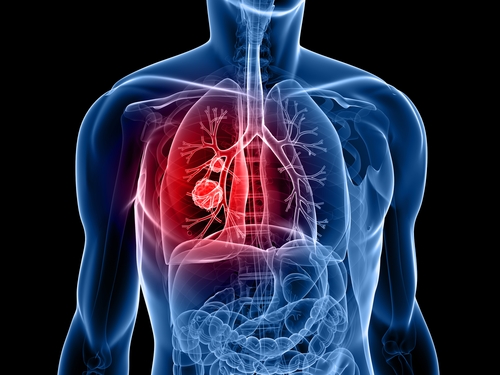Lung Cancer
Definition of Lung Cancer
Lung cancer is a malignant growth in the lung that is characterized by uncontrollable cell division in this tissue. Most of these cancers spread (metastasize) to other tissues of the body if not treated promptly. This cancer usually arises from the epithelial cells of the lung.
Cause of Lung Cancer
Cancer arises because of the defect in the DNA and the environmental insults adds fuel to fire. There are a lot of causes of lung cancer:
-
Smoking
-
Radon gas exposure
-
Asbestos
-
Air pollution
-
Genetic predisposition to lung cancer
-
Exposure to ionizing radiations
-
Toxic gases like fumes from paintings
-
Silica dust
-
Some of the products of combustion like incomplete combustion of coal.
Signs and Symptoms of Lung Cancer
Some of the signs and symptoms that suggest the presence of lung cancer are:
-
 Coughing
Coughing -
Blood in sputum
-
Wheezing
-
Shortness of breath
-
Weight loss
-
Fever
-
Fatigue
-
Clubbing of fingernails
-
Chest pain
-
Bone pain
-
Difficulty in swallowing
Most of these symptoms are nonspecific and the cancer has spread to other regions of the body before patient seeks medical attention. The common sites where the lung cancer can spread are: brain, bone, adrenal glands, opposite lung, liver and kidneys. About 10% of these patients are asymptomatic and the cancer is diagnosed incidentally on routine chest radiograph.
Risk Factors for Lung Cancer
Most of the risk factors of lung cancer are the same as those mentioned previously in the section of causes. These are:
-
Cigarette smoking
-
Passive smoking (secondhand smoke)
-
Radon exposure
-
Diesel exhaust
-
Some forms of silica
-
A positive family history of lung cancer
-
Radiation therapy to the chest in the past, e.g. radiotherapy for breast cancer
-
Certain diets, most importantly beta-carotene supplements in smokers
-
Arsenic in drinking water
Diagnosis of Lung Cancer
Some of the ways by which lung cancer can be diagnosed are:
-
Chest radiograph
-
CT scan of the chest
-
Bronchoscopy
-
CT-guided biopsy of the lung
-
Histological examination of the suspicious tissue to confirm the diagnosis
Treatment of Lung Cancer
The choice of treatment depends upon the spread of cancer, its specific cell line, and the patient’s performance status. Common treatments are:
Surgery
This method is more useful when the tumor has well defined margins (boundaries) and has not spread to other parts of the body. In most cases the affected lobe of the lung is removed and very rarely the whole lung.
Radiotherapy
It is used as a treatment option in situations where surgery cannot be done. High energy radiations target the tumor and destroys it.
Chemotherapy
Chemotherapy is often used with radiotherapy. The drugs mostly used are: cisplatin and etoposide. Other drugs used are paclitaxel, docetaxel, pemetrexed, etoposide or vinorelbine.
Palliative care
It is the type of care that aims at relieving the patient of the dreadful sufferings of the disease. This care relieves the signs and symptoms and is temporary as it has no effect on the underlying cause.
